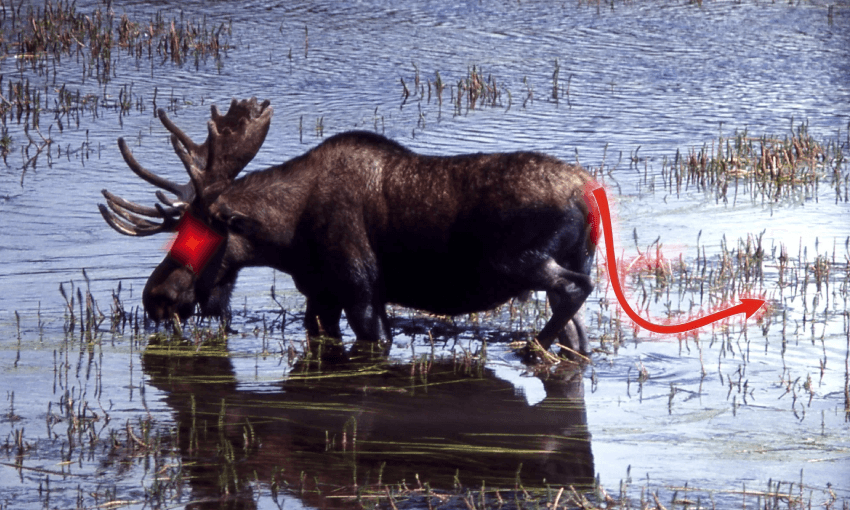Ten moose were upended into the Dusky Sounds in 1910. Now, their descendants are getting their day in the sun.
The climate crisis is affecting wildlife all over the country: rockhopper penguin populations are in drastic decline, tuatara eggs aren’t hatching females, and the ice walls keeping predators away from kea are melting.
But it’s not all bad news: the largest animal in Fiordland has the smallest population, but the most chance of surviving the climate crisis. That’s right, the moose boom is coming.
The glacial hills of Fiordland aren’t much like the forests and tundras of Saskatchewan, and it’s long been debated that it’s an inappropriate place for moose. “The climate down there isn’t suitable for moose,” said Blake Cole, an experienced huntsman and a regular on the Fiordland tracks. Luckily for hunters like Cole, that’s about to change. The changing climate is accelerating and, maybe, moose evolution is too.
Moose were released into Fiordland because it’s the wettest part of New Zealand, and a significant portion of the moose diet is aquatic vegetation. They like to munch on your standard leaves and bark – young or disturbed forests are prime moose fodder – but they also bloody love a swamp lettuce. Usually, they eat the swamps bare in one season and go back to nibbling on bushes for the next.
The climate crisis – or climate Christmas for some lucky ungulates – is offering aquatic veg the chance to branch out. “Rapid change supports rapidly breeding species that humans usually consider invasive,” said botanist and natives keeper Sam Willyams. “Watercress is both invasive and edible.” Watercress grows commonly in New Zealand, where it enjoys growing in cool streams; like the edges of a southern fiord, or an alpine river. It’s already present in Fiordland, but hasn’t taken over the National Park the moose live in.
NIWA predicts Fiordland will see the highest increase in rainfall in New Zealand as the climate changes. Already, rain falls at least 200 days a year in these misty hills. The glaciers are melting faster than snow can fall. There are about to be a few more fjords in Fiordland.
And that’s just how the moose like it. Moose, like other species of deer, can swim very well. They’re known to dive up to six metres for their lunch. When the weather gets too warm for their thick coats, they go for a swim to cool off.
A classic moose-friendly environment is a dense, tall forest with some disturbed areas – free from logging or fires – for easy nibbling, and dotted with ponds and streams for paddling and snacking.
Whether the Fiordland moose’s aquatic foraging abilities resemble their ancestors’ is unknown. This is because they’re inbred. There was a founding population of eight (ten were released but two were shot soon after), but species have come back from worse.
In New Zealand, we can turn to the black robin. In 1980, there were only five of these fluffy chaps. Now, 250 of them live in the Chatham Islands. Interestingly, they seem to have few negative effects despite having such an extreme population bottleneck.
Moose are not short-lived birds, and may not be as good at processing inbreeding. However, that’s not a huge problem yet. They’re known to maintain low population densities. They’re very big and they eat a lot, but they rarely deplete their resources. They also avoid inbreeding as long as possible, so the eight moose who survived likely built as varied a gene pool as possible in their first couple of generations of breeding.
This means the Fiordland moose are probably only slightly inbred and are still capable of diving into glacial pools to pig out.
In 1985, the Norwegian island of Vega was colonised by three splash-happy moose. By 1992, the population was up to 24, including four fresh immigrants in 1991. The effects of inbreeding on the population were a slower birth rate and smaller babies. Small calves are less likely to survive predator attacks and cold weather.
The moose has no natural predators in New Zealand, except the lawless huntsmen and gold miners who sneak around the fjords in the dead of night. The weather is only getting warmer. There is no pressure on their population save their own cautious instincts. Given their low population, is it possible they could be a protected species? “I think the Conservation Act specifically deals with New Zealand native species,” said Fiordland Department of Conservation spokesperson Jamie McAulay.
Is it a pest, then? “It certainly isn’t at a high enough density to be causing problems.”
Well, not yet. Fiordland is getting warmer and wetter but will never be unbearably hot for a moose. There isn’t as much bark and pine for them to eat, but there are waterways and scrub full of tasty leaves.
Thanks to climate change, Kiwi moose hunters like Ken Tustin may soon be seeing the waterworld version of a moose: smaller, bolder, and more aquatic. Whether they’ll prove a danger to humankind is yet to be seen.

